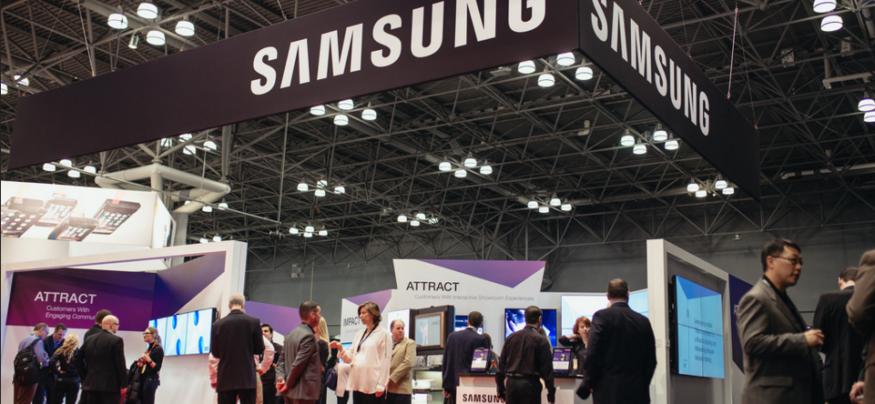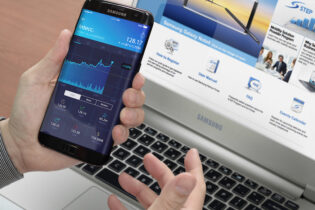[HED] Throwing Clients a Curve
[DEK] Curved monitors are all the rage among gamers and PC enthusiasts, but their immersive qualities mesh well with businesses too.
At the International Consumer Electronics Show (CES) in Las Vegas earlier this year, curved monitors were front and center, with dozens of new products pushing the envelope on size, resolution, and functionality. Still, it was hard to find a curved-monitor demonstration that didn’t feature the thrill-packed visuals of some first-person shooter video game.
To be sure, curved monitors are highly coveted by gamers, who are increasingly attracted to the way these peripherals mimic our natural field of view and immerse the player in the gaming experience. Since human eyes are naturally curved, they are more drawn to curved shapes, according to Seoul National University Hospital (SNUH) ophthalmology expert Dr. Kim Sung-joon. People prefer curves over hard lines and angles, and viewing the curves of an object triggers relief in the brain, says Dr. Kim.
That’s all fine and good for gamers and hobbyists, and for those fascinated with the science of looking at things, but what about channel resellers that have to make the case for such technologies to B2B clients in the work-a-day world? Do curved monitors have a place in business IT? As it turns out, the same qualities that make curved monitors attractive to high-end consumer users can help sell the devices to select business organizations.
Channel partners should consider four things when preparing to pitch clients on curved monitors.
Show and Tell
The first thing most folks notice when seeing a curved monitor for the first time is the subtlety of the bend. In fact, the curve is barely noticeable until the viewer gets fairly close to the device — usually within two feet.
At that point, however, the curve and its effect on the viewing experience become immediately obvious. The “wow factor” was in evidence throughout CES this year as many show-goers got their first glimpse of the peripherals and witnessed first-hand the benefits of the curve.
The lesson for partners is that describing curved monitors in a sales pitch will take you only so far. Be prepared to demonstrate the device in-person to give the buyer a chance to experience the curved monitor’s visceral benefits. With these cutting-edge devices, a picture really is worth 1,000 words.
Aim Vertically
Not every business will be a suitable customer for a curved monitor. That’s why it’s important for IT solution providers to target their sales efforts toward vertical industries where high resolution, viewing comfort, and an immersive visual experience are tied to business goals and outcomes.
Graphic design and multimedia editing, and businesses that require employees to spend long hours viewing images on screen, are proving fertile ground for curved monitors. The natural presentation and field of view supplied by these devices reduce neck and eye strain, SNUH’s Dr. Kim points out.
Another vertical to consider is the financial industry. According to PCWorld, curved monitors are becoming increasingly popular with traders and quantitative analysts who often use multiple-screen displays made up of two or four high-definition monitors. Today’s curved monitors, with their ability to connect to multiple devices and their capacity for picture-in-picture viewing, can be used to create advanced setups for financial clients that push the envelope on performance while increasing comfort for those required to look at monitors for up to 12 hours a day.
Target Use Cases
Just as vertical applications can help hone the curved-monitor sales pitch, so, too, can a thorough understanding of the client’s use case. For example, Samsung’s SE650C series of business-grade curved monitors might be perfect as the basis for an updated video-editing station, a financial trading console, or an IT network operations center. The 23.5-inch S24E650C and the 27-inch S27E650C both feature a 16:9 aspect ratio, 1920 x 1080 (full HD) resolution, VESA-standard mounting capability, and an ergonomically flexible stand with tilt, swivel, height, and pivot adjustments that allow users to dial in the perfect view.
The pair also features Samsung’s “Flicker Free” and “Eye Saver” technologies, which further reduce eye strain by reducing screen flicker and allowing users to filter the amount of blue light emitted by the display.
Other clients, however, may need to blend basic compute power with the advanced optics of the curved display. That’s where solutions such as the Samsung ATIV ONE 7 curved all-in-one PC can fill the bill. The ATIV ONE 7 features an Intel Core i5 processor, 8GB of memory, and a brilliant 27-inch curved screen to make working with files such as medical charts and images less taxing and more productive.
Make It a Value Play
Curved monitors are significantly more expensive than their old-school flat-panel counterparts. That makes them valuable margin opportunities for channel partners, of course, but it also makes honing the value proposition from the outset critical to sales success. Curved displays won’t sell as a price play, and their ROI needs to be calculated based on increased functionality and improved productivity
Leading with the price tag on a $550 curved monitor won’t win over many business IT decision-makers in an age where traditional monitors can be had for one-quarter that much. Demonstrating just how much of a difference that subtle curve can make for users who work, produce, and innovate in front of a computer screen will take the conversation much further toward the sale.







